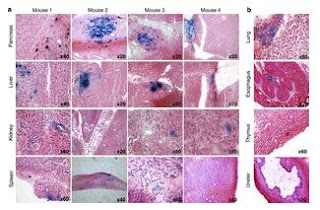 |
| Determination of the site for donor cell engraftment of young wild-type mice-muscle-derived stem/progenitor |
Previous investigators are still serious doubts whether the stem cell dysfunction may affect the aging process or the result of it. Research conducted by scientists from the University of Pittsburgh managed to improve the health of the mice two to three times longer than expected, after the mice were injected stem cells / progenitor, which originated from young muscle of healthy animals. Research carried out this is evidence that stem cell dysfunction is the cause of aging.
“Our experiments showed that mice that have progeria, a disorder of premature aging, were healthier and lived longer after an injection of stem cells from young, healthy animals,” Dr. Niedernhofer (associate professor in Pitt’s Department of Microbiology and Molecular Genetics and the University of Pittsburgh Cancer Institute (UPCI)) said. “That tells us that stem cell dysfunction is a cause of the changes we see with aging.”
Their team examined a stem/progenitor cell population derived from the muscle of progeria mice and found that compared to those from normal rodents, the cells were fewer in number, did not replicate as often, didn’t differentiate as readily into specialized cells and were impaired in their ability to regenerate damaged muscle. The same defects were discovered in the stem/progenitor cells isolated from very old mice.
“We wanted to see if we could rescue these rapidly aging animals, so we injected stem/progenitor cells from young, healthy mice into the abdomens of 17-day-old progeria mice,” Dr. Huard said. “Typically the progeria mice die at around 21 to 28 days of age, but the treated animals lived far longer – some even lived beyond 66 days. They also were in better general health.”
As the progeria mice age, they lose muscle mass in their hind limbs, hunch over, tremble, and move slowly and awkwardly. Affected mice that got a shot of stem cells just before showing the first signs of aging were more like normal mice, and they grew almost as large. Closer examination showed new blood vessel growth in the brain and muscle, even though the stem/progenitor cells weren’t detected in those tissues.
In fact, the cells didn’t migrate to any particular tissue after injection into the abdomen. “This leads us to think that healthy cells secrete factors to create an environment that help correct the dysfunction present in the native stem cell population and aged tissue,” Dr. Niedernhofer said. “In a culture dish experiment, we put young stem cells close to, but not touching, progeria stem cells, and the unhealthy cells functionally improved.”
Animals that age normally were not treated with stem/progenitor cells, but the provocative findings urge further research, she added. They hint that it might be possible one day to forestall the biological declines associated with aging by delivering a shot of youthful vigor, particularly if specific rejuvenating proteins or molecules produced by the stem cells could be identified and isolated.
Source: http://www.upmc.com/MediaRelations/NewsReleases/2011/Pages/Shot-Stem-Cells-Made-Aging-Mice-Live-Longer.aspx
To Memorabillia:
ReplyDeleteThank you, I'll go there